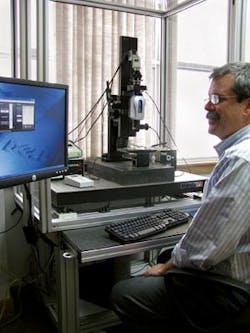Zoom lenses target machine vision
In machine-vision applications such as robot guidance and component inspection, images of objects with different sizes may need to be captured. While multiple cameras can be deployed to perform this task, motorized zoom lenses also can be used to capture multiple images with different magnifications. Conventional zoom lenses usually consist of stepper or dc motors combined with cams, rotary encoders, and lead screws. In such lenses, lens position resolution is determined by the number of steps in each revolution of the optical encoder and the pitch of the lead screw.
“Apart from the magnification factor of the zoom lens,” says Bob Zinter, director of technology at Qioptiq Imaging Solutions (Fairport, NY, USA; www.qioptiqimaging.com), “two of the most important parameters in specifying motorized zoom lenses are centration and magnification repeatability. While the magnification repeatability shows to what extent the lens will achieve the same magnification over a number of zoom cycles and is specified in percent, the centration repeatability, specified in microns, shows to what extent there will be a positional error in the x-y field of view.”
Qioptiq’s Fetura zoom imaging system, for example, features a magnification range of 12.5:1, a high magnification repeatability of ±0.04%, and a high magnification centration repeatability of ±6 µm (measured at the camera; measurements at the object would be significantly smaller because they are divided by the magnification factor). Both specifications are called out at ±2s (standard deviations).
Fetura camless linear zoom-lens system features a magnification range of 12.5:1.
For its Fetura design, the company has chosen to improve the conventional cam-driven approach and develop a system that uses two dc motors to drive both a variator lens and a compensator lens along a linear axis. While the variator lens varies the magnification factor of the image, the compensator lens compensates for the displacement of the image to bring the object being viewed into focus.
To accomplish this, both the variator and compensator are moved axially in a fixed, nonlinear relationship. To achieve the highest repeatability, Hall-effect sensors mounted to the lens-carrier system read the position of each lens cell from a glass scale inscribed with gold elements that have a 40-µm pitch. Interpolation techniques allow the lenses to be positioned with 0.4-µm resolution (see figure on p. 18).
To control the motion of each lens, two Texas Instruments (Dallas, TX, USA; www.ti.com) DSPs are used in a master/slave configuration. The DSPs provide positional information to the motor controllers and are used in conjunction with other hardware to send and receive commands from the Fetura graphical user interface—Pulse. In this way, the system developer can set the magnification range of the lens system and configure custom setups for the device over a USB or RS-232 interface. System developers can incorporate this code into their machine-vision software to develop automated imaging applications.
Additionally, Fetura’s Pulse control software provides developers with built-in calculation for a variety of available auxiliary lenses to modify Fetura’s magnification, working distance, resolution, and related optical-performance parameters. By integrating the Infinity Macro Lens Accessory into a Fetura lens system, the integrator can transform Fetura from a micro-imaging lens system covering small fields of view over relatively short working distances (468—32 mm) to a macro vision lens capable of imaging increasingly large fields of view, from 50 mm out to infinity. When the optical system components are selected, the corresponding details on the lens type, working distance, minimum and maximum magnification are shown in the graphical user interface.
Perhaps the most noticeable advantages of the Fetura camless, linear zoom lens design are those of zoom speed (lens travel time), extended service life, and sustainable performance precision held across the extended service life. “While a conventional zoom lens takes approximately 8 s to move across a 12.5:1 magnification range, Fetura can cover its entire magnification range in 0.8 s—ten times faster,” says Zinter.
Fetura delivers service life in excess of 1 million full zoom cycles. A single Fetura lens unit yields 1 million zoom cycles in 440 hours, a throughput yield that would require nine conventional 12X zoom lenses and 4400 hours to complete. Given a list price of $6250, using a Fetura lens translates to a savings of nearly three times a conventional lens approach.


